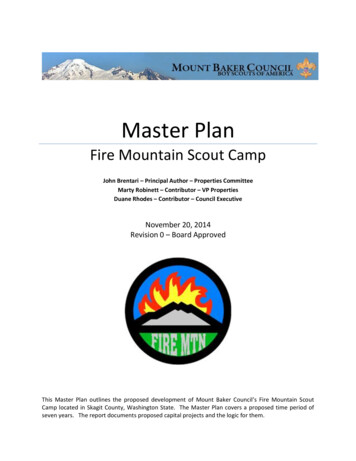
Transcription
Butte County Office of Emergency ManagementCamp Fire ResponseCounty-Wide After Action ReportBUTTE COUNTYCAMP FIRE RESPONSECOUNTY-WIDE AFTER ACTION REPORTAugust 20201
Butte County Office of Emergency ManagementCamp Fire ResponseCounty-Wide After Action ReportAcknowledgements and ThanksThanksThe response to the Camp Fire required support from multiple County, City, State, and Federalresponders; hundreds of volunteers; and countless residents providing a helping hand toneighbors and community members. Butte County would like to take this opportunity to sincerelythank each and every individual who contributed their time and resources to assist with theresponse to the Camp Fire as well as the continued recovery efforts. Words cannot describe theselflessness, dedication, and sheer determination of the staff, volunteers, and communitymembers. You have inspired us with your heroism and sacrifice. To all the other agencies,organizations, and jurisdictions who reached out immediately and offered staff, supplies, andadvice, you have our sincerest gratitude. We hope that the lessons learned and the best practiceshighlighted in this report can serve as a guide, passing our experiences on to the next in order toenhance response and recovery capabilities everywhere.DedicationThis document is dedicated to all those who experienced loss due to the Camp Fire. The loss oflife, loved ones, property, and connection to home is a heavy weight to bear. Our community willcontinue to feel loss for as long as we are here to remember. This document is meant to ensurewe never forget. More importantly, it is meant to celebrate our resilient spirit, help guide our stepsas we rebuild stronger, and promote preparedness through the transparent sharing of ourexperiences and the many lessons we learned.ContributorsThe authors of this After Action Report (AAR) would also like to thank those who helped to put thisdocument together. The appendices of this document contain a list of individuals who helpedauthor the document, review drafts, participate in interviews, provide data, and participate in theCamp Fire Hot Washes. In addition, countless individuals provided their thoughtful feedbackthrough a general survey distributed to Butte County employees and partner agencies.In particular, the Project Oversight Team for this effort deserves our appreciation for theirleadership and review in the development of this document, especially while still coping with theimpacts of the event.2
Butte County Office of Emergency ManagementCamp Fire ResponseCounty-Wide After Action ReportThis AAR was written and developed by Constant Associates, Inc., which is a third-party, privatesector emergency management and public health preparedness consulting firm contractedthrough donated emergency response funds (via Direct Relief) from the Camp Fire to compile thisAAR.3
Butte County Office of Emergency ManagementCamp Fire ResponseCounty-Wide After Action ReportTable of ContentsACKNOWLEDGEMENTS AND THANKS. 2TABLE OF CONTENTS . 4EXECUTIVE SUMMARY . 5INTRODUCTION . 8Purpose and Scope of the Report.8Data Gathering Process .9Organization of Report .11Description .12Timeline .14ANALYSIS OF FINDINGS . 16Notification Alert and Warning .16County EOC Operations .20Public Information .23Evacuation .26Sheltering and Reunification .35Walmart Camp .40Donations Management .42Animal Care and Control .44Resource Management.48Volunteer Management.51Remains Recovery & Search and Rescue.56Missing Persons .63Repopulation .66Recovery .71FINAL THOUGHTS . 73APPENDICES . 74Acknowledgements .74Stakeholder Interview Participant List .78Hot Wash Participant List.79Hot Wash Feedback Form Summaries .82Survey Data Summary .85Acronyms .1004
Butte County Office of Emergency ManagementCamp Fire ResponseCounty-Wide After Action ReportExecutive SummaryLosing the Battle, Winning the WarWe Are All InPartner ThoughtsThe tragedy experienced due to the Camp Fire cannot be“We were creative,understated. It will remain a marker in the County’s history forbecause we had to be.years to come. The Camp Fire remains the deadliest and mostI would tell staff, whendestructive fire in California history. It was a devastating eventyou hit a wall climb it!”that burned over 150,000 acres, destroyed nearly 19,000 Shari McCrackenstructures, and fatally claimed 85 lives. While the fire took soChief Administrativemuch from so many, one thing persisted, the undyingOfficercommitment of the community to help one another survive theunthinkable. This selflessness extended from neighbors helpingevacuate one another to employees and volunteers workingcountless hours to help the friends, family, and constituents of Butte County. Throughout ButteCounty, the region, the State of California, and beyond, responders performed heroically with asingular focus – to support the survivors.This report is written with the acknowledgement that, though not every battle was won, ButteCounty staff, its partner organizations, and all other involved stakeholders fought relentlessly towin the war. This report will document both lessons learned from this tragic event as well as bestpractices in hopes that the County and other jurisdictions may take heed, apply these concepts,and enhance capacity for future responses. While this report cannot change the outcomes of theCamp Fire, by sharing what was learned, it can potentially save lives, protect property, andmitigate the impacts of future disasters.With that in mind, this AAR highlights specific best practices that the County feels could benefitother jurisdictions from the perspective of the responder. The report organizes all findings intospecific themes generated from data collected on the response to the Camp Fire. Each themeaddresses both strengths and areas for improvement identified by County staff and responsepartners. Specific recommendations for improvement are listed for each theme and aresummarized in a separate document, the Corrective Action Plan (CAP).The After Action ProcessThe production of this AAR was made possible through Camp Fire recovery funds generouslydonated by Direct Relief. Funds were utilized to contract Constant Associates, Inc. to develop thisreport as a third-party emergency management and public health preparedness consulting firm.Constant Associates provided a team of experts to collect data through documentation reviews,stakeholder interviews, surveys, and facilitated group discussions.5
Butte County Office of Emergency ManagementCamp Fire ResponseCounty-Wide After Action ReportAfter a thorough analysis of the data collected, findings and recommendations for improvementwere outlined. This report focuses on a defined timeframe and aims to capture the best practicesand lessons learned that were demonstrated in the Camp Fire response efforts beginningNovember 8, 2018 and ending March 1, 2019. Best practices are provided throughout thedocument as to share procedures, tactics, and solutions utilized during and following the CampFire so that other jurisdictions can enhance their preparedness and response capability.A separate Camp Fire Recovery After Action Report is under development, and will further outlinerecovery activities such as debris management coordination. As such, analysis of recoveryactivities has not been included within this document, with the exception of re-entry andrepopulation, local assistance center activation, and other activities which overlapped with theresponse period and led to the transition into recovery operations.Recommendations for improvement have been captured and are listed within the Analysis ofFindings section of this report. Recommendations have been developed to support continued andfuture action the County is making to enhance its preparedness, response, recovery, andmitigation capabilities. The most notable significant strengths and areas for improvement arehighlighted below.Significant Strengths Creative problem-solving was implemented to successfully address the unprecedenteddemands of the Camp Fire. Butte County’s culture of collaboration, staff familiarity, and sense of dedicated responsibilityserved as a driving force throughout the Camp Fire response and recovery effort. Butte County’s nightly press conferences demonstrated transparency and a commitment toproviding accurate and timely incident updates to the public and media. Butte County, non-governmental organizations (NGO) partners, and neighboring jurisdictionscame together to swiftly meet the evolving demands of the incident.Significant Areas For Improvement Mass notification system failures resulted in notifications not reaching the intended audience. The County Emergency Operations Center (EOC) faced significant challenges with receivinginformation and maintaining situational awareness from the fire-affected areas. Gaps in the process for managing spontaneous, unaffiliated volunteers led to a host ofchallenges within the Camp Fire response and recovery effort. There were inconsistent thresholds across the County for the transition from the responsephase to the recovery phase, which resulted in staggered efforts between agencies and staff,as well as extremely strained staffing conditions.6
Butte County Office of Emergency ManagementCamp Fire ResponseCounty-Wide After Action ReportConclusionDisasters, by definition, exceed the impacted jurisdiction’s capacity to sufficiently manage aresponse through utilization of its own available resources. The magnitude and complexity of theCamp Fire required the assistance of state and federal governments, a plethora of responseagencies, and a vast number of volunteers. The findings and recommendations of this AAR aremade with the full appreciation of tragic loss of life and property that Butte County experienced.7
Butte County Office of Emergency ManagementCamp Fire ResponseCounty-Wide After Action ReportIntroductionThis AAR provides a thorough analysis of Butte County’s response to the Camp Fire that tookplace from the initial reporting on November 8, 2018 to recovery efforts up to March 1, 2019.While recovery efforts continue to this day, this report synthesizes and presents a timeline ofevents and overarching summary of the immediate impacts of the event and actions taken byButte County and partner organizations during and shortly after the fire took place. Informationpresented in this report was derived from a detailed document review, including responsedocumentation as well as plans and procedures; an online survey; virtual and in-person interviews;and facilitated working-group sessions.The information collected was analyzed by a team of experts to provide key findings – bothstrengths and areas of improvement. These findings are presented in the Analysis of Findingssection of this report. These findings are organized by the critical functions of the response forease of understanding and to provide context on the incident. Recommendations for improvementare included at the conclusion of each subsection.An overarching sentiment shared by County responders was an overall sense of gratitude towardsthose that supported them – especially those that shared their recent lessons learned and bestpractices from Sonoma County and the City of Santa Rosa. Less than a year after the Tubbs andNuns Fires tore through their communities, City and County staff from these previously impactedjurisdictions arrived on-site to support their neighbors in Butte County. Their recent experienceshelped to positively shape the response in Butte County. Therefore, to pay it forward, this reportshares specific best practices, providing tools and techniques to those communities that maybenefit in their time of need.Purpose and Scope of the ReportThis AAR was commissioned by the Chief Administrative Officer (CAO) with the intent tocomprehensively collect best practices and lessons learned in an effort to enhance the capabilitiesof the County and to pass on experiences to others. Therefore, the data gathering, analysis, andreporting process mainly covers the County response to the Camp Fire, County policies andprocedures, and the County-wide implications of local, State, and Federal activities. While theCounty is still in recovery from the Camp Fire as of the writing of this document, this report focuseson County activities between November 8, 2018 and March 1, 2019. A separate Camp FireRecovery After Action Report will cover recovery activities such as debris managementcoordination and ongoing behavioral health services.8
Butte County Office of Emergency ManagementCamp Fire ResponseCounty-Wide After Action ReportData Gathering ProcessSummaryThis AAR has been compiled using a four-step data gathering process, as outlined in Figure 1below. This process included a comprehensive review of pre-existing plans and incidentdocumentation, a survey of responders and stakeholders, group interviews according to responseroles, and facilitated discussions with County and partner response officials. All data was reviewedand analyzed by a team of emergency management professionals to provide a fair and honestanalysis of the response and the development of realistic and actionable improvementrecommendations.Figure 1: Camp Fire AAR Data Gathering ProcessDocument ReviewExperts from Constant Associates collected and reviewed response documents along withestablished policies and procedures to compile the notes for this Report. A sampling of thosedocuments includes: Butte County Emergency Operations Center (EOC) Action PlansButte County EOC Resource RequestsButte County Sheriff’s Incident Action Plans (IAP)Butte County Unified Disaster Recovery Operations Center (DROC) Activation PlansEOC to DROC Transition PlanButte County Emergency Operations Plan (EOP)Butte Operational Area Policy and Procedures for Issuing Emergency Passes9
Butte County Office of Emergency ManagementCamp Fire ResponseCounty-Wide After Action ReportSurveyAn electronic survey was developed and distributed widely tocollect individual responder feedback. This data was analyzed todetermine if any of the issues that were identified required furtherinquiry. Survey participants were asked to share what theyobserved as strengths as well as any issues that stifled responseefforts. Survey participants were also asked to share any specificrecommendations for improvement. This data provided a detailedview of the response and was used to identify data gaps whichwere filled through stakeholder interviews, working-groupdiscussion, open-source research, and incident documentationreview.InterviewsPartner Thoughts“We couldn’t havedone this withoutMutual Aid.Responders fromSanta Rosa, Shasta,Redding, andSonoma County whohad just experiencedthe Tubbs Fire,helped us tounderstand whatwould come next.” Shari McCracken,Butte County CAOOne-on-one and small group interviews were conducted todetermine critical issues and strengths related to the responseefforts. Interviews also provided an opportunity to discuss the rootcause of issues identified through the survey and facilitated groupdiscussion process. Approximately 11 interviews were conducted to include areas such as publicinformation, initial alert and notification, environmental health, animal sheltering, evacuation andrepopulation, and more.Facilitated Group Discussions - Hot WashesTwo facilitated group discussions called hot washes were designed and conducted to engageCounty stakeholders in refining the overall incident timeline of key events, working acrossdepartments to determine root causes of issues during the response, and collectively workingtowards identifying improvements.The first hot wash focused on the County-wide response to the Camp Fire and engagedparticipants from County Departments, including Sheriff Honea and CAO Shari McCracken, aswell as a representative from Direct Relief. The second hot wash was held specifically for thePublic Health and medical community to inform the development of a public health-specific AAR.10
Butte County Office of Emergency ManagementCamp Fire ResponseCounty-Wide After Action ReportOrganization of ReportThis AAR was organized in the following manner in order to give readers an overview of the CampFire, providing context to the unprecedented and relentless conditions responders endured, aswell as the complicating factors that ensued which at times stymied the response. The corecontent of the report is included in the Analysis of Key Findings Section. This section organizeskey findings into major themes. Those themes share strengths and areas for improvementresultant from the data collection process. Recommendations for improvement are included at theconclusion of each theme.11
Butte County Office of Emergency ManagementCamp Fire ResponseCounty-Wide After Action ReportIncident OverviewDescriptionBackground OverviewThe communities of Butte County have historically been found to be at high risk for wildfire events.Since 1999, there have been 13 large wildfires that have burned through areas of the NorthernCalifornian foothills. The terrain and climate have routinely posed potential hazards for ButteCounty and resulted in numerous activations and responses. The 2008 Humboldt Fire and ButteLightning Complex were particularly large events and precursors to the Camp Fire for ButteCounty.The Camp Fire started on the morning of November 8, 2018. The Pulga community saw the earlyrumblings of an erupting fire that quickly spread throughout major communities in Butte County.With the downing of a power transmission line, the state’s deadliest and most destructive wildfireripped through fields, homes, businesses, neighborhoods, and entire towns. Shortly after, theonslaught of fleeing residents and massive evacuation efforts became a race against time for thecommunity to respond to quickly and appropriately.Development of the Camp FireOn November 6, 2018, Pacific Gas & Electric Company (PG&E) had notified customers of anintended power shutdown due to increasingly high winds and low humidity. The region was at veryhigh risk for a wildfire given the development of dry, hot, and fast winds and a rapidly decreasinghumidity index. The National Weather Service had issued a red-flag warning for the NorthernCalifornian region for November 7 and 8.With alarming weather conditions, the high fire risk resulted in the decision to cut power to portionsof Butte County on November 8. PG&E warned residents on November 7 of the potential for powershutoffs. However, the power was never shutoff, and on the morning of November 8, a powertransmission line issue was reported near the Community of Pulga. At 6:33 AM, the first reports ofa fire in a wooded area by the Poe Creek Dam started to come in. The small brushfire had alreadygrown to ten acres by the time first responders arrived on the scene.The fire area was initially only accessible by a narrow dirt road, and it would have been dangerousto send engines directly to respond. In addition, the decision to call for air resources was delayeddue to the high winds and sunrise limitations. By the time resources had arrived, the fire hadspread 19 miles across the local mountain range.As the fire was spreading, the Community of Pulga received the first evacuation notice at 7:13AM. Concow and Paradise also hastily received evacuation notices. While typically agencies can12
Butte County Office of Emergency ManagementCamp Fire ResponseCounty-Wide After Action Reportforecast fire direction, the Camp Fire was particularly unpredictable due to the weather conditions.Due to spot fires being picked up by strong wind gusts, the fires were rapidly spreading from allends and at multiple locations simultaneously due to ember ignition. The speed of the fire affectedevacuation routes, closing in cities and blocking off exits.Both the Butte County Public Health Department (BCPHD) Department Operations Center (DOC)and the County Emergency Operations Center (EOC) activated quickly on the morning ofNovember 8, 2018, with the DOC activated by 8:00 AM and the EOC by 9:00 AM. Staff coming into their normal jobs between 7:00 AM and 9:00 AM that morning quickly staffed positions in theDOC and EOC, while others were immediately deployed to potential shelter locations.As the fire ripped through the County, residents described the results as “apocalyptic”. Even asearly as 8:00 AM, conditions were described as dark skies, flaring embers, and thick, smoke-filledair. Those conditions eventually became the resounding alarms for residents to begin selfevacuating whether or not evacuation orders were in place.Most notably, the community had banded together to propel evacuation efforts in the midst ofcommunication failures. As the fire appeared on their doorsteps, neighbors informed residents andoffered evacuation assistance and eventual shelter. At one point, traffic had become so congestedthat many began to flee on foot. In the midst of escaping, many had stopped to pick up those whowere stuck without transportation, for their cars had ignited.Most of the senior citizen population and residents with disabilities were aided by fellow communitymembers who offered to drive them to safety. Schools, hospitals, and other large centers werequickly evacuated in large part with the help of their own faculty and staff, who stayed behind tocoordinate those efforts before leaving themselves. Some residents jumped into a creek by theConcow Reservoir; with others fortunate enough to have been rescued by other residents onboats.Some who evacuated were able to seek shelter with family and friends nearby. Additionally,evacuation shelters were set up to house displaced residents, with the Butte County Fairgroundsand other sites being used to shelter large animals and pets. Eventually, the Camp Fire forcedevacuations in Paradise, Magalia, Centerville, Concow, Pulga, Butte Creek Canyon, Berry Creek,and Yankee Hill. Additionally, it threatened several nearby communities, including the City of Chicoand the City of Oroville.Response from the CommunityDue to the speed of the fire, the response priorities quickly switched from fire suppression toevacuation. The fire was moving too quickly and there were not enough resources to stop it intime. In the midst of evacuations, first responders were diligent in directing those rescue efforts tosave as many lives as possible. As resources were blocked due to evacuation gridlock, manycircled around town evacuating residents and pulling them into points of protection wherever theycould, such as gas stations, parking lots, and local churches. All the while, their own homes werepossibly being lost in the chaos.13
Butte County Office of Emergency ManagementCamp Fire ResponseCounty-Wide After Action ReportBy November 10, resources from all over the Western United States were deployed. This included5,596 firefighters, 622 engines, 75 water tenders, 101 fire crews, 103 bulldozers, and 24helicopters. To further complicate matters, the Woolsey Fire in Southern California was occurringsimultaneously; requiring resources from 17 other states.After the FireCalifornia Department of Forestry and Fire Protection (CAL FIRE) finally reported the fire 100%contained on November 25, after 17 days of burning. Starting on November 16, a Local AssistanceCenter (LAC) was opened at the local mall in Chico to assist residents in accessing services fromLocal, State, and Federal agencies throughout the recovery process. This was also known as theDisaster Recovery Center (DRC). Since the fire, a severe housing crisis has continued to impactButte County. By December of 2018, the populations in Chico, Oroville, and Gridley had swelledby about 20%, with the influx of more than 20,000 people since the previous year. Many individualslingered in shelters until the last shelter was closed in February of 2019. Some waited fortemporary housing units from the Federal Emergency Management Agency (FEMA), which forsome, took more than six months to secure. Since then, many residents have moved completely,with a large number moving out of state because of the high cost of living and lack of availableand affordable housing in the area. Debris management and cleanup has taken up a considerableamount of resources, as the Camp Fire resulted in one of the largest hazardous material cleanupoperations in the State’s history. Recovery efforts continue to this day alongside efforts to rebuildin a manner that mitigates the impact of future disasters.TimelineThe following timeline reflects activities and actions that transpired in the wake of the 2018 CampFire, highlighting key response efforts between November 8, 2018 and March 1, 2019. The datathat informed this timeline was collected from a variety of sources to include interviews with Countystakeholders, hot washes, the Butte County Sheriff’s Office (BCSO) Twitter feed, County EOCaction plans, CAL FIRE incident documentation, and open source publications and articles. Assuch, it may not reflect all events that occurred, but only those deemed most relevant to providecontext for the remainder of this document, and those timestamps which could be verified throughprovided sources.14
Butte County Office of Emergency ManagementCamp Fire ResponseCounty-Wide After Action Report15
Butte County Office of Emergency ManagementCamp Fire ResponseCounty-Wide After Action ReportAnalysis of FindingsNotification Alert and WarningSummaryCritical to the Camp Fire response operation was the ability to rapidly alert residents andbusinesses of the fast-moving, unpredictable, and life-threatening fire conditions and provideinformation that would promote safety and save lives. The BCSO oversees the County’s massnotification and alert process and is responsible for disseminating accurate and timely messagesto the public leading up to, during, and post disasters. On November 8, 2018, Butte Countyestablished and maintained a forward-leaning posture with regards to notification, alert, andwarning amidst a myriad of challenges presented by fire conditions, staffing shortages, andtechnology failures.StrengthsFinding 1: Butte County’s culture of collaboration, staff familiarity, and sense ofdedicated responsibility empowered the notificat
practices from Sonoma County and the City of Santa Rosa. Less than a year after the Tubbs and Nuns Fires tore through their communities, City and County staff from these previously impacted jurisdictions arrived on-site to support their neighbors in Butte County. Their recent experiences helped to positively shape the response in Butte County.










